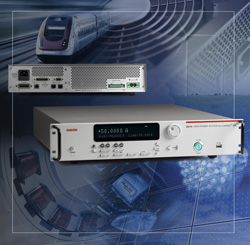- News
5 April 2011
Keithley launches high-power semiconductor test instrument
Electrical test instrument and system provider Keithley Instruments Inc of Cleveland, OH, USA has launched the Model 2651A High Power System SourceMeter instrument, the latest addition to its Series 2600A System SourceMeter family.
 Designed specifically for characterizing high-power electronics, the Model 2651A provides what is claimed to be the widest current range available, critical for R&D, reliability and production test applications such as testing high-brightness light-emitting diodes (HB-LEDs), power semiconductors, DC–DC converters, batteries, and other high-power materials, components, modules, and subassemblies.
Designed specifically for characterizing high-power electronics, the Model 2651A provides what is claimed to be the widest current range available, critical for R&D, reliability and production test applications such as testing high-brightness light-emitting diodes (HB-LEDs), power semiconductors, DC–DC converters, batteries, and other high-power materials, components, modules, and subassemblies.
Like each member of the Series 2600A family, the Model 2651A offers a flexible, four-quadrant voltage and current source/load coupled with precision voltage and current meters. It combines the functionality of multiple instruments in a single full-rack enclosure: semiconductor characterization instrument, precision power supply, true current source, DMM (digital multimeter), arbitrary waveform generator, V or I pulse generator, electronic load, and trigger controller, and is fully expandable into a multi-channel, tightly synchronized system via Keithley’s TSP-Link technology. Unlike competitive solutions, which typically have limited power, measurement speed and/or resolution, Keithley claims,the Model 2651A can source or sink up to 2000W of pulsed power (±40V, ±50A) or 200W of DC power (±10V@±20A, ±20V@±10A, ±40V@±5A). It can also make precise measurements of signals as low as 1pA and 100 microvolts at speeds up to 1 microsecond per reading.
The Model 2651A provides a choice of digitizing or integrating measurement modes for precise characterization of both transient and steady-state behavior. Two independent analog-to-digital (A/D) converters define each mode — one for current and the other for voltage — which run simultaneously for accurate source readback without sacrificing test throughput.
The digitizing measurement mode’s 18-bit A/D converters allow the capture of up to 1 million readings per second for continuous 1-microsecond-per-point sampling, making this mode the most appropriate choice for waveform capture and measuring transient characteristics with high precision. Competing solutions must average multiple readings to produce a measurement result and often do not allow the measurement of transient behavior, Keithley claims.
The integrating measurement mode, based on 22-bit A/D converters, optimizes the instrument’s operation for applications that demand the highest possible measurement accuracy and resolution. This ensures precise measurements of the very low currents and voltages common in next-generation devices. All Series 2600A instruments provide integrating measurement mode operation.
Connecting two Model 2651A units in parallel via TSP-Link expands the system’s current range from 50A to 100A. This is 2.5–5 times greater than the nearest competing solution, the firm claims. The voltage range can be expanded from 40V to 80V when two units are connected in series. The embedded Test Script Processor (TSP) included in all Series 2600A instruments simplifies testing by allowing users to address multiple units as a single instrument so that they act in concert. The built-in trigger controller in the Model 2651A can synchronize the operation of all linked channels to within 500ns. These capabilities provide what is claimed to be the broadest dynamic range available, suiting a broad variety of high-current, high-power test applications, including:
- power semiconductor, HB-LED, and optical device characterization and testing;
- characterization of GaN, SiC, and other compound materials and devices;
- semiconductor junction temperature characterization;
- reliability testing;
- high-speed, high-precision digitization; and
- electro-migration studies.
To minimize device self-heating during tests (a common problem with high-power semiconductors and materials), the Model 2651A offers high-speed pulsing capabilities that allow users to source and measure pulses with high accuracy. Pulse widths from 100 microseconds to DC and duty cycles from 1% to 100% are programmable. Competing solutions are typically hampered by limited flexibility for programming the instrumentation’s duty cycle, Keithley claims.
TSP Express (Keithley’s LXI-based I–V test software utility) is embedded in the instrument, so there is no need for software installation or programming. From basic to advanced tests, TSP Express delivers device data in three steps: connect, configure, and collect. It also simplifies connecting instruments to allow higher pulsing levels. Results can be viewed in either graphical or tabular format and then exported to a .csv file for use with spreadsheet applications. Two other powerful software tools for creating test sequences are also provided: the Test Script Builder application supports creating, modifying, debugging, running, and managing TSP scripts; an IVI-based LabVIEW driver simplifies integrating the Model 2651A into LabVIEW test sequences.
Keithley Semiconductor test instrument
www.keithley.com/products/dcac/currentvoltage/highcurrent/?mn=2651A
http://keithley.acrobat.com/p50501284
Join Semiconductor Today's LinkedIn networking and discussion group
